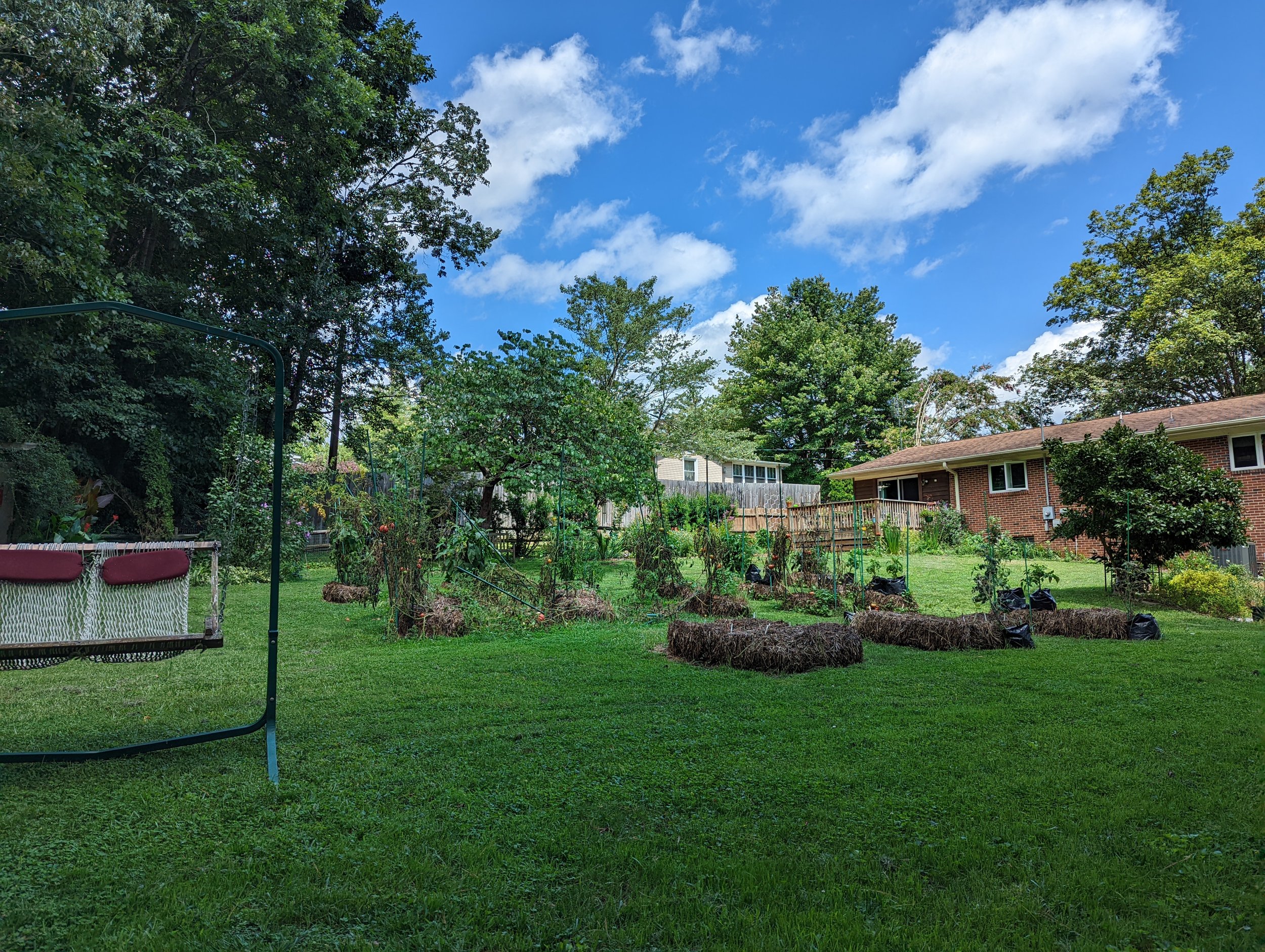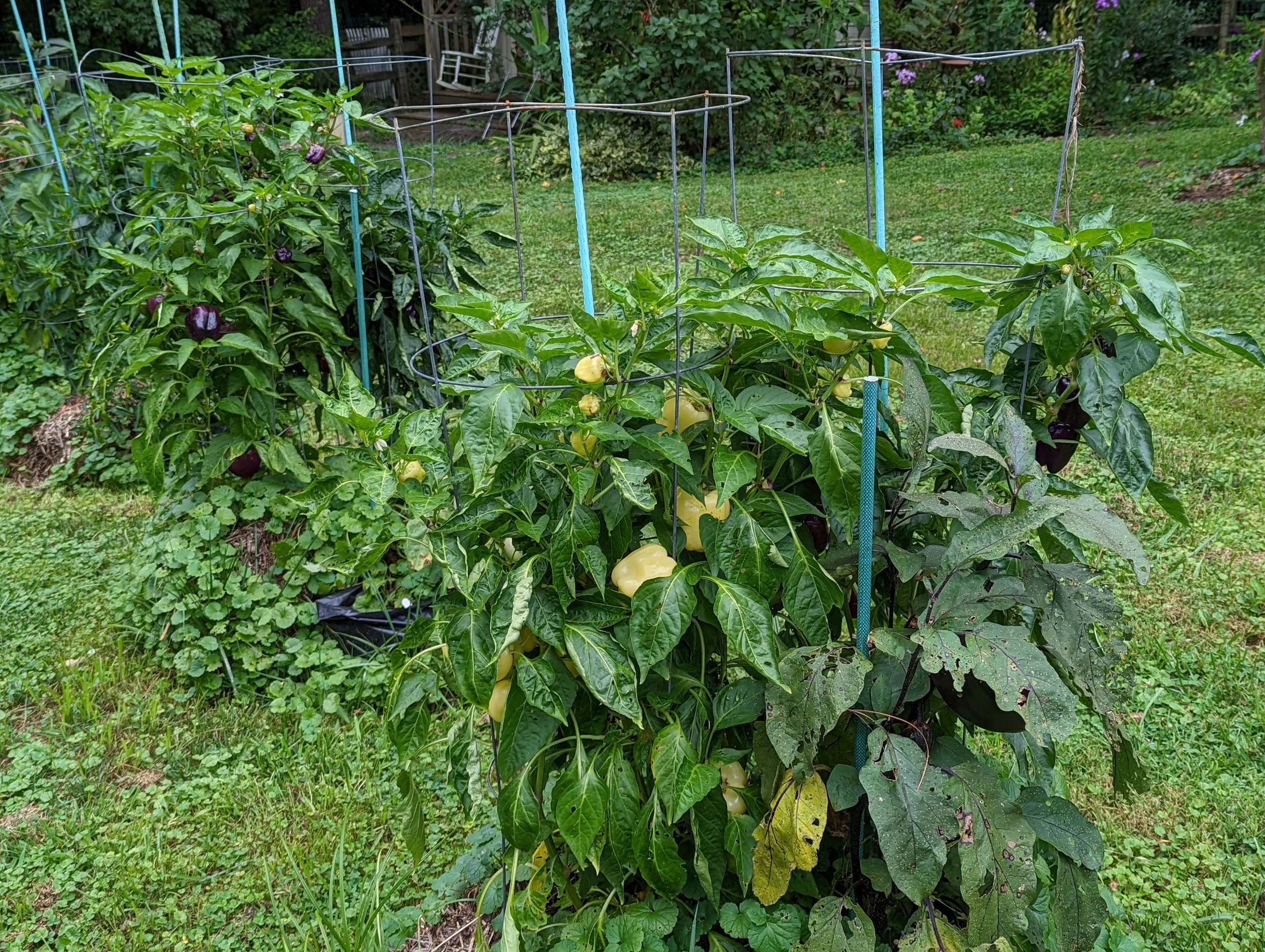Busy Bumblebee on our Salvia Coccinea Coral Nymph in late August
What a rare event! We made big salads tonight for dinner where our own lettuce co-existed with our own tomatoes! Typically the lettuce is long gone before the tomatoes arrive. I wish I took a picture - Sue and I make big salads when they are the main dinner course. Aside from lettuce and tomatoes (tonight I used Dwarf Liz’s Teardrop and Glory F1 hybrid) were chopped sweet orange peppers (Trader Joe-sourced), our own cucumbers (Unagi hybrid, which I highly recommend), blueberries (picked just a few miles down the road), a few halves of Rainer cherries (Trader Joe again). I put some sliced deli turkey on mine, and Sue likes Kalamata olives on hers. There were also some craisins, toasted walnuts, some torn basil leaves (it is so nice to have fresh basil to use), grated Syrah soaked Bella Vista (yep - Trader Joe), olive oil, fresh squeezed lemon juice and black pepper. Sue adds a bit of Balsamic to hers. It fills a plate - but being on average about 95% water, has but few calories - so it is an amazing feast that fills us up. We’ve been doing salads like this for many, many years.
It was such a quiet day - Sundays here seem to be that way. The birds aren’t as vocal as they were, with just the house wren and song sparrows filling the spaces. Hummingbirds are around again after a bit of an absence, at our two feeders or our various flower gardens, particularly loving the phlox, salvia and crocosmia. The main morning task was watering - afternoon was for hammock time and a book, and tomato harvesting. We love our days here in Hendersonville. When Sue and I are in our back yard corner, the three dogs tend to hang around near us - except when some sound sends them running to see if a mole or vole or rabbit or squirrel - or delivery truck - threatened their domain. We could watch them frolic and interact all day (and sometimes it seems like we do!).
I’ve fallen behind on answering emails, which are mostly gardening questions at this time of year. I hope to get caught up tomorrow, but sometimes it just seems a bit overwhelming, working on issues in others’ gardens at the same time that I am working on those showing up in my own. If yours is one of the unanswered emails, apologies - you will get a response soon! (note added August 25 - yes, I did get caught up - but am falling behind again!)
Walking around the garden after dinner is hitting that time when it can be intimidating. Tomato growing means issues, and those issues accelerate as the season progresses, the plants get big, and the warm, humid weather takes its toll. Not only is there the regular watering, feeding, tying and diseased foliage removal, daily harvests are now here - and the decisions on what to do with it. I always have plans to take it slow, sample each variety carefully, take lots of pictures - then - WHAM - there are 20 or 30 or more pounds of tomatoes sitting on this or that table, all ripening at once. Which need to be tasted? Which need their seeds saved? Is it canning time yet? Something is leaking - which tomato is the culprit? It is just about at that point in the year, and I know it will flash by, as I will be very busy daily for the next month or more.
I often wonder how I got to this place - 40 years of gardens, two books, a collaborative on line course, Zooms and interviews and phone calls and emails and Instagrams and blogs. Mostly I wonder what’s next - what to stop, what to start, and how I can be in the moment more, have less “lists” - start to disencumber myself from being so consistently “on” and busy. I am so happy that I left Facebook and Twitter behind. Instagram is really my main sharing format, and though I have a love/hate feeling about all social media, I will likely stick with it for some time. I’ve come to realize that my blogging really is mostly for me - my record, my archive, and a place to do posts like this - thinking out loud, ruminating about things. My feeling is that blogs don’t often get read - too many words, too much time needed to do so, and our society is moving more and more toward brief sound bites. That, though, it not me - I love to write, love words, love the whole act of putting thoughts down (no longer on paper, but through my fingers, from this keyboard). Part of me is ready to do less gardening - smaller gardens for sure, feeling less tied to the yard, feeling more free to take off for days to kayak or hike. Part of me is ready to move away from the Zooms and the sharing. And an even bigger part of me is not ready for that quite yet - even though I burn out each year doing this, I somehow reenergize over the fall and winter and do it all again the following year. It does give me things to ponder as I garden, and mow, and hike, and laze in the hammock.
The above was all written in mid July. Now, on August 25 as I finish this blog, it all still rings true. Tuesday and Wednesday of this week I had wonderful experiences providing Zooms for the plant breeding department at Cornell (on the Dwarf Tomato Project), and Penn State Master Gardeners (on tomatoes). One more Zoom remains - the tomato talk - to an Orange County NC Master Gardener group in late October. Then - that’s it!
Things that are now done - Better Call Saul (for which I am very sad - I loved that series, and thought that the finale was brilliant), the Friday Office Hours for my Growing Epic Tomatoes course with Joe Lamp’l, and my weekly Thursday Instagram Lives. This is a relief for me. It opens up space to do more things, feel less tied down and obligated.
I now embark on completing the book on the Dwarf Tomato Project - that will be my main focus between now and next spring. When not working on that, it will be all about hiking, or kayaking, or reading, or listening to music - or lazing in the hammock with Sue. This all makes me very, very happy.
Finally - some ripe sweet bell peppers! Royal Purple, Chocolate Bell and Orange Bell, late August. Seed saving time!






















